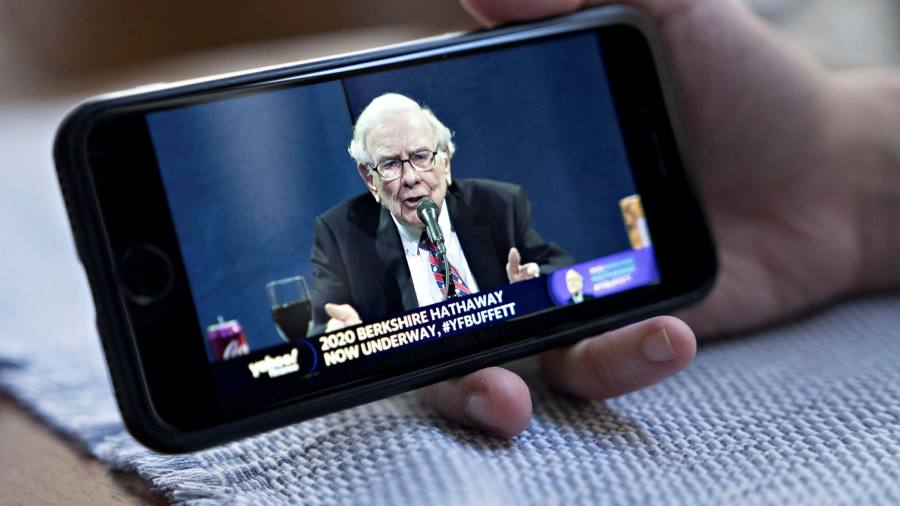[ad_1]
“Bonds are not the place to be these days,†Warren Buffett, the Berkshire Hathaway chief told shareholders in his latest annual letter last month. Many in markets agree with the Sage of Omaha’s judgment — and for good reason.
The clouds over the global and US economies are steadily thinning thanks to Covid-19 vaccines being distributed, while governments are intent on spending big in order to sustain a broad recovery in activity with a clear goal of restoring full employment.
This week President Joe Biden indicated that a fully vaccinated adult US population by the end of May was his administration’s target, setting the stage for a more open economy when Memorial day barbecues are fired up.Â
The improving macro backdrop presents bond investors with little choice other than to upgrade expectations for both growth and inflation and reduce their exposure to the risk of a pronounced rise in market interest rates this year. Despite their recent abrupt climb, 10-year benchmarks still remain at historically low levels, a point of vulnerability not lost on investors.
“The fear level is high among financial advisers and portfolio managers with rates seen heading higher,†said Jason Bloom, head of fixed income and alternatives strategies for ETFs at Invesco.Â
Already, broad baskets of US and global government debt have declined more than 3 per cent in value since the start of January. That may not sound like much of a decline. However, the main US Treasury index has escaped recording a negative year of performance since 2013 when the famed “taper tantrum†sparked a surge in 10-year interest rates that resulted in a total return of minus 2.75 per cent.

This year’s abrupt slide in bond prices highlights a nasty aspect to long-maturity paper beyond 10 years: their prices can fall quickly when the starting point of interest rates is historically low. The iShares exchange traded fund of US Treasury bonds with a maturity of more than 20 years has registered a loss beyond 11.4 per cent so far this year, eroding a chunk of its 18 per cent gain in 2020.
The speed of the recent rise in both nominal and inflation-adjusted rates has so far not triggered a drop across equities, credit and in currencies against the US dollar that is of the scale to concern Federal Reserve policy officials. Speaking on Thursday, Fed chair Jay Powell said they were observing the recent rise in rates, but it was not yet ringing alarm bells unless it prompted “a persistent tightening in financial conditionsâ€.
The bond market was predictably unhappy to hear this message and equities, led by highly valued tech shares, slid on Thursday. But this kind of central bank communication makes sense in several respects. Policy officials can hardly acknowledge an improving economy and then rush to signal increased bond buying or cap 10-year interest rates at the first market shudder.
Allowing the bond market to take some air out of ebullient valuations in equities and housing through higher 10-year rates is an appropriate policy approach given how far asset prices have risen and when economic growth is picking up. The US 10-year currently remains below the 1.80 per cent level seen before the arrival of the pandemic. Arguably, that looks low because the current macro outlook is the reverse of the slowdown that was evident in early 2020.
Longer term, this leaves the bond market, investors in general and central banks facing a difficult period of waiting until the tone of the economic recovery is well established. One way of gauging progress on that front will be the path of inflation-adjusted interest rates, a barometer of the economy’s long-term growth prospects. At minus 0.7 per cent, the 10-year real yield remains at its lowest since 2013 and well inside an average of plus 0.30 per cent since the start of 2010.Â
“Until the economy catches up, markets face a testing time establishing fair values in long-term interest rates that reflect the underlying pace of growth and inflation,†said Steve Blitz, chief US economist at TS Lombard.
An improving macroeconomic story will at some point ratify whether a protracted bear market in bonds is warranted ahead of tighter Fed policy. The extent of the recovery and whether it sustains annual inflation beyond the Fed’s target of 2 per cent are key factors.
“There is the likelihood of more fiscal stimulus relative to what was seen during the last decade,†said Ashish Shah, co-chief investment officer of fixed income at Goldman Sachs Asset Management. However, he said there were “natural limits†in how far interest rates would rise. These include pressures on inflation from demographics and technology while “the debt overhang will also prevent economic growth from sustaining a pick-upâ€.
At times since 2009, the bond market has teased investors with bouts of rising interest rates, only for pressure to ease because subsequent economic growth was modest and accompanied by benign inflation pressure. While the bond market is feeling the heat at present, the temperature will cool should the economic story emulate the pattern of the previous decade.
[ad_2]
Source link





